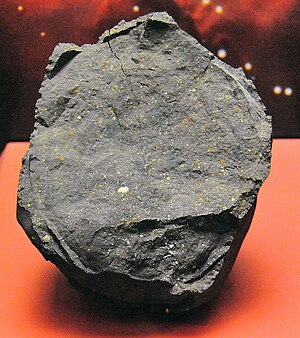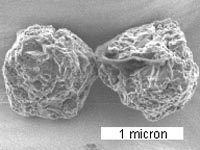Murchison meteorite
0% vetted
| Murchison | |
|---|---|
 A Murchison meteorite specimen at the National Museum of Natural History (Washington) | |
| Type | Chondrite |
| Class | Carbonaceous chondrite |
| Group | CM2 |
| Composition | 22.13% total iron, 12% water |
| Shock stage | S1-2 |
| Country | Australia |
| Region | Victoria |
| Coordinates | 36°37′S 145°12′E / 36.617°S 145.200°ECoordinates: 36°37′S 145°12′E / 36.617°S 145.200°E[1] |
| Observed fall | Yes |
| Fall date | 28 September 1969 |
| TKW | 100 kg |
 Pair of grains from the Murchison meteorite | |
|
| |
The Murchison meteorite is a large meteorite that fell to earth near Murchison, Victoria, in Australia, in 1969. It is one of the most studied meteorites due to its mass (>100 kg), the fact that it was an observed fall, and that it belongs to a group of meteorites rich in organic compounds.
History[edit | hide all | hide | edit source]
On 28 September 1969 at about 10:58 local time, near the town of Murchison, Victoria, in Australia, a bright fireball was observed to separate into three fragments before disappearing,[1] leaving a cloud of smoke. About 30 seconds later, a tremor was heard. Many fragments were found over an area larger than 13 square kilometres (5.0 sq mi), with individual mass up to 7 kilograms (15 lb); one, weighing 680 grams (1.5 lb), broke through a roof and fell in hay.[1] The total collected mass exceeds 100 kilograms (220 lb).
Classification and composition[edit | hide | edit source]
The meteorite belongs to the CM group of carbonaceous chondrites (see meteorite classification). Like most CM chondrites, Murchison is petrologic type 2, which means that it experienced extensive alteration by water-rich fluids on its parent body[2] before falling to Earth. CM chondrites, together with the CI group, are rich in carbon and are among the most chemically primitive meteorites.[3] Like other CM chondrites, Murchison contains abundant CAIs. Over 15 amino acids, some of the basic components of life, have been identified in the meteorite[4] by multiple studies. All the amino acids found in the Murchison meteorite have been synthesized in laboratory experiments by the action of electric discharge on a mixture of methane, nitrogen, and water with traces of ammonia.[4]
Organic compounds[edit | hide | edit source]

Murchison contains common amino acids such as glycine, alanine and glutamic acid as well as unusual ones like isovaline and pseudoleucine.[5] A complex mixture of alkanes was isolated as well, similar to that found in the Miller–Urey experiment. Serine and threonine, usually considered to be earthly contaminants, were conspicuously absent in the samples. A specific family of amino acids called diamino acids was identified in the Murchison meteorite as well.[6]
The initial report stated that the amino acids were racemic and therefore formed in an abiotic manner because amino acids of terrestrial proteins are all of the L-configuration. Later the amino acid alanine, which is also a protein amino acid, was found to have an excess of the L-configuration,[7] which led several to suspect terrestrial contamination according to the argument that it would be "unusual for an abiotic stereoselective decomposition or synthesis of amino acids to occur with protein amino acids but not with non-protein amino acids."[8] In 1997, L-excesses were also found in a non-protein amino acid, isovaline,[9] suggesting an extraterrestrial source for molecular asymmetry in the Solar System. At the same time, L-excesses of alanine were again found in Murchison but now with enrichment in the isotope 15N,[10] however, the isotopic pairing was later contested on analytical grounds.[11] The list of organic materials identified in the meteorite was extended to polyols by 2001.[12]
| Compound class[13] | Concentration (ppm) |
|---|---|
| Amino acids | 17-60 |
| Aliphatic hydrocarbons | >35 |
| Aromatic hydrocarbons | 3319 |
| Fullerenes | >100 |
| Carboxylic acids | >300 |
| Hydrocarboxylic acids | 15 |
| Purines and pyrimidines | 1.3 |
| Alcohols | 11 |
| Sulphonic acids | 68 |
| Phosphonic acids | 2 |
Although the meteorite contained a mixture of left-handed and right-handed amino acids, most amino acids used by living organisms are left-handed in chirality, and most sugars used are right-handed. A team of chemists in Sweden demonstrated in 2005 that this homochirality could have been triggered or catalyzed, by the action of a left-handed amino acid such as proline.[14]
Several lines of evidence indicate that the interior portions of well-preserved fragments from Murchison are pristine. A 2010 study using high resolution analytical tools including spectroscopy, identified 14,000 molecular compounds including 70 amino acids in a sample of the meteorite.[15][16] The limited scope of the analysis by mass spectrometry provides for a potential 50,000 or more unique molecular compositions, with the team estimating the possibility of millions of distinct organic compounds in the meteorite.[17]
Nucleobases[edit | hide | edit source]
Measured purine and pyrimidine compounds were found in the Murchison meteorite. Carbon isotope ratios for uracil and xanthine of δ13C = +44.5‰ and +37.7‰, respectively, indicate a non-terrestrial origin for these compounds. This specimen demonstrates that many organic compounds could have been delivered by early Solar System bodies and may have played a key role in life's origin.[18]
See also[edit | hide | edit source]
References[edit | hide | edit source]
- ↑ 1.0 1.1 1.2 Meteoritical Bulletin Database: Murchison
- ↑ Airieau, S. A.; Farquhar, J.; Thiemens, M. H.; Leshin, L. A.; Bao, H.; Young, E. (2005). "Planetesimal sulfate and aqueous alteration in CM and CI carbonaceous chondrites". Geochimica et Cosmochimica Acta. 69 (16): 4167–4172. Bibcode:2005GeCoA..69.4167A. doi:10.1016/j.gca.2005.01.029.
- ↑ "Planetary Science Research Discoveries: Glossary".
- ↑ 4.0 4.1 Wolman, Yecheskel; Haverland, William J.; Miller, Stanley L. (April 1972). "Nonprotein Amino Acids from Spark Discharges and Their Comparison with the Murchison Meteorite Amino Acids" (PDF). Proc. Natl. Acad. Sci. USA. 69 (4): 809–811. Bibcode:1972PNAS...69..809W. doi:10.1073/pnas.69.4.809. PMC 426569
. PMID 16591973.
- ↑ Kvenvolden, Keith A.; Lawless, James; Pering, Katherine; Peterson, Etta; Flores, Jose; Ponnamperuma, Cyril; Kaplan, Isaac R.; Moore, Carleton (1970). "Evidence for extraterrestrial amino-acids and hydrocarbons in the Murchison meteorite". Nature. 228 (5275): 923–926. Bibcode:1970Natur.228..923K. doi:10.1038/228923a0. PMID 5482102.
- ↑ Meierhenrich, Uwe J.; Bredehöft, Jan Hendrik; Jessberger, Elmar K.; Thiemann, Wolfram H.-P. (2004). "Identification of diamino acids in the Murchison meteorite". PNAS. 101 (25): 9182–9186. Bibcode:2004PNAS..101.9182M. doi:10.1073/pnas.0403043101. PMC 438950
. PMID 15194825.
- ↑ Engel, Michael H.; Nagy, Bartholomew (29 April 1982). "Distribution and enantiomeric composition of amino acids in the Murchison meteorite". Nature. 296 (5860): 837–840. Bibcode:1982Natur.296..837E. doi:10.1038/296837a0.
- ↑ Bada, Jeffrey L.; Cronin, John R.; Ho, Ming-Shan; Kvenvolden, Keith A.; Lawless, James G.; Miller, Stanley L.; Oro, J.; Steinberg, Spencer (10 February 1983). "On the reported optical activity of amino acids in the Murchison meteorite". Nature. 301 (5900): 494–496. Bibcode:1983Natur.301..494B. doi:10.1038/301494a0.
- ↑ Cronin, John R.; Pizzarello, S. (1997). "Enantiomeric excesses in meteoritic amino acids". Science. 275 (5302): 951–955. Bibcode:1997Sci...275..951C. doi:10.1126/science.275.5302.951. PMID 9020072.
- ↑ Engel, Michael H.; Macko, S. A. (1 September 1997). "Isotopic evidence for extraterrestrial non-racemic amino acids in the Murchison meteorite". Nature. 389 (6648): 265–268. Bibcode:1997Natur.389..265E. doi:10.1038/38460. PMID 9305838.
- ↑ Pizzarello, Sandra; Cronin, JR (1998). "Alanine enantiomers in the Murchison meteorite". Nature. 394 (6690): 236. Bibcode:1998Natur.394..236P. doi:10.1038/28306.
- ↑ Cooper, George; Kimmich, Novelle; Belisle, Warren; Sarinana, Josh; Brabham, Katrina; Garrel, Laurence (20 December 2001). "Carbonaceous meteorites as a source of sugar-related organic compounds for the early Earth". Nature. 414 (6866): 879–883. Bibcode:2001Natur.414..879C. doi:10.1038/414879a. PMID 11780054.
- ↑ Machalek, Pavel (17 February 2007). "Organic Molecules in Comets and Meteorites and Life on Earth" (PDF). Department of Physics and Astronomy. Johns Hopkins University. Archived from the original (PDF) on 17 December 2008. Retrieved 2008-10-07.
- ↑ Córdova, Armando; Engqvist, Magnus; Ibrahem, Ismail; Casas, Jesús; Sundén, Henrik (2005). "Plausible origins of homochirality in the amino acid catalyzed neogenesis of carbohydrates". Chem. Commun. (15): 2047–2049. doi:10.1039/b500589b. PMID 15834501.
- ↑ Walton, Doreen (15 February 2010). "Space rock contains organic molecular feast". BBC News. Retrieved 2010-02-15.
- ↑ Schmitt-Kopplin, Philippe; Gabelica, Zelimir; Gougeon, Régis D.; Fekete, Agnes; Kanawati, Basem; Harir, Mourad; Gebefuegi, Istvan; Eckel, Gerhard; Hertkorn, Norbert (16 February 2010). "High molecular diversity of extraterrestrial organic matter in Murchison meteorite revealed 40 years after its fall" (PDF). PNAS. 107 (7): 2763–2768. Bibcode:2010PNAS..107.2763S. doi:10.1073/pnas.0912157107. PMC 2840304
. PMID 20160129. Retrieved 2010-02-16.
- ↑ Matson, John (15 February 2010). "Meteorite That Fell in 1969 Still Revealing Secrets of the Early Solar System". Scientific American. Retrieved 2010-02-15.
- ↑ Martins, Zita; Botta, Oliver; Fogel, Marilyn L.; Sephton, Mark A.; Glavin, Daniel P.; Watson, Jonathan S.; Dworkin, Jason P.; Schwartz, Alan W.; Ehrenfreund, Pascale (20 March 2008). "Extraterrestrial nucleobases in the Murchison meteorite" (PDF). Earth and Planetary Science Letters. 270: 130–136. arXiv:0806.2286
. Bibcode:2008E&PSL.270..130M. doi:10.1016/j.epsl.2008.03.026. Retrieved 2008-10-07.
External links[edit | hide | edit source]
| Wikimedia Commons has media related to Murchison meteorite. |
- Rosenthal, Anne M. (12 February 2003). "Murchison's Amino Acids: Tainted Evidence?". Astrobiology Magazine.
- Matson, John (15 February 2010). "Meteorite That Fell in 1969 Still Revealing Secrets of the Early Solar System". Scientific American.
This article incorporates public domain material from websites or documents of the National Aeronautics and Space Administration.
| This article uses material from Murchison meteorite on Wikipedia (view authors). License under CC BY-SA 3.0. |

